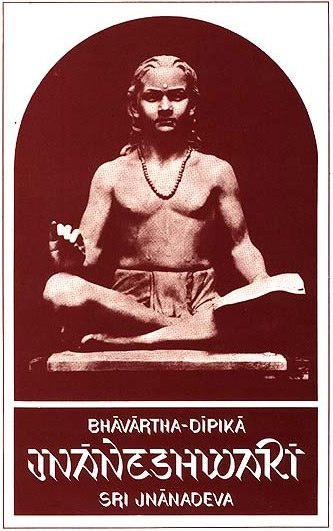Jnaneshwari (Bhavartha Dipika)
by Ramchandra Keshav Bhagwat | 1954 | 284,137 words | ISBN-10: 8185208123 | ISBN-13: 9788185208121
This is verse 11.10 of the Jnaneshwari (Bhavartha-Dipika), the English translation of 13th-century Marathi commentary on the Bhagavad-Gita.—The Dnyaneshwari (Jnaneshwari) brings to light the deeper meaning of the Gita which represents the essence of the Vedic Religion. This is verse 10 of the chapter called Vishvarupa-darshana-yoga.
Verse 11.10
Verse 11.10: “Possessing many mouths and eyes—of manifold and wonderous aspects—wearing numerous celestial ornaments brandishing many a Divine weapon, (197)
Commentary called Jnaneshwari by Jnaneshwar:
Then there did Arjuna gaze on myriads of faces that shone like the stately mansions of the Lord of Lakshmi; splendid treasures of radiant beauty flung wide open; so superbly charming did he behold the faces of Hari that looked like blooming woodlands of bliss or like beauty crowned and enthroned. Amidst these beautiful faces there appeared not a few that wore horrid looks as if they were legions of grim death rushing out for destruction; or as if they were the very jaws of death’s yawning; or as if they were citadels of the king of terror—death, or big pouches jetting out fire of world conflagration.
The brave (Arjuna) there beheld such horrid faces in that Omnipresent vision; there were innumerable others too that were singularly bedecked and serene. And even to the ‘eye of knowledge,’ the end of the faces for ever remained out of sight. Arjuna then turned his astonished gaze to the eyes of the Omnipresent Lord. And he there beheld myriads of eyes like so many rows of suns that resembled full-blown lotus flowers of varied colours. And from below the eyebrows beamed forth brownish rays of fiery eyes that looked like lightning flashes shot from clusters of clouds for the universal conflagration.
The sight of these wonderful marvels brought home to the son of Pandu the boundless variety of visions in one divine Omnipresence. He then eagerly asked himself, “where then are his feet, where is his crown, and where are his arms?” And so ever increasing became his longing to behold them. And how should the desire of Partha—the favourite of supremely good fortune—fall short of fulfilment? Could the quiver of God Siva ever send forth a missile that is futile or that misfires? And could the lips of Brahma ever utter syllables that are empty? Arjuna thus had a vision full and complete of the limitless Omnipresence. His sight, at a glance, feasted on all the limbs of that supreme presence which even the Vedas could not comprehend. From top to toe his eyes surveyed the majestic grandeur of that Omnipresence bedecked with many jewelled ornaments. As the supreme Brahman appeared as a visible person bestrewn with the splendour of decoration made of his perfect being, it is indeed beyond the power of words to say what that shining beauty looked like.
The glorious splendour is the light by which the very Sun and Moon shine and by whose lifesustaining power the whole universe is made manifest. Where is that mind that can picture the refulgence of the beauty that surrounded the supreme person? Arjuna beheld Brahman itself adorning Brahman. And as he then glanced with the inward eyes the long and straight arms of that Person, he beheld them flashing weapons that cut the very world-consuming fire. Arjuna then said that the supreme God filled the entire universe, so that He himself was alike body and soul, arms and weapons, body and beauty. The rays of that light became a furnace in which the very stars burst into pieces like parched gram (phuṭāṇe), or the fire itself, scorched by the touch, was frightened into hiding under the surface of the sea. Then he (Arjuna) saw the immeasurable hands of that All-pervading Person—hands as though besmeared with vapours of the deadliest poison, or brandishing weapons that looked advancing forests of lightning.
